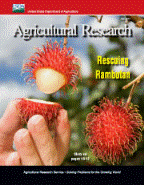United States Department of Agriculture: Agricultural Research Service, Lincoln, Nebraska

Agricultural Research Magazine
Date of this Version
1-2013
Document Type
Article
Citation
Agricultural Research January 2013
Abstract
When energy officials proposed using crop residues to produce cellulosic ethanol, concerned soil scientists took to the fields to learn more about how these residues protect soil from erosion and enhance soil quality. Agricultural Research Service soil scientist Brian Wienhold focused on a single component of residue— the corncob.
“We didn’t have data on how postharvest cob residues might protect soil quality,” says Wienhold, who works in the ARS Agroecosystem Management Research Unit in Lincoln, Nebraska. “But corncobs make up 20 percent of residue by weight, which means that the average U.S. production of corn could provide 40 to 50 million tons of cobs for feedstock every year.”
Wienhold led colleagues in studies that compared runoff from no-till corn fields where postharvest crop residues were either removed or retained. The scientists also removed the cobs from half of the test plots that were protected by the residues. Then they generated two simulated rainfall events; the first occurred when the fields were dry, and the next occurred 24 hours later when the soils were almost completely saturated.
During the first event, on plots where residue was removed, runoff began around 200 seconds after the “rain” began, whereas runoff in the residueprotected plots didn’t start until around 240 seconds after it started to “rain.” Runoff from the residue-free plots contained 30 percent more sediment than runoff from all the residue-protected plots. The presence or absence of cobs on the residue-protected plots did not affect sediment loss rates.
Included in
Agriculture Commons, Animal Sciences Commons, Food Science Commons, Plant Sciences Commons

